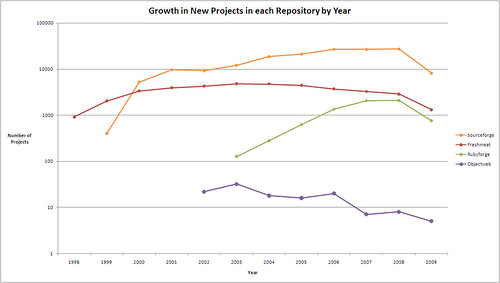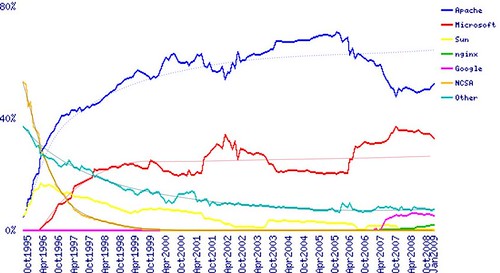One of the activities we are working on to distract ourselves from the lure of beaches and mountain walks is the creation of a preliminary model of actor/actions for the OSS environment, trying to estimate the effect of code and non-code contributions and the impact of OSS on firms (adopters, producers, leaders – following the model already outlined by Carbone), and the impact of competition-resistance measures introduced by firms (pricing and licensing changes are among the possibility). We started with some assumptions on our own, of course; first of all, rationality of actors, the fact that OSS and traditional firms do have similar financial and structural properties (something that we informally observed in our study for FLOSSMETRICS, and commented over here), and the fact that technology adoption of OSS is similar to other IT technologies.
Given this set of assumptions, we obtained some initial results on licensing choices, and I would like to share them with you. License evolution is complex, and synthesis reports (like the one that is presented daily by Black Duck) can only show a limited view of the dynamics of license adoption. In Black Duck’s database there is no account for “live” or “active” projects, and actually I would suggest them to add a separate report for only the active and stable ones (3% to 7% of the total, and actually those that are used in the enterprise anyway). Our model predicts that in the large scale, license compatibility and business model considerations are the main drivers for a specific license choice; in this sense, our view is that for new projects the license choice is more or less not changed significantly in the last year, and that can be confirmed by looking at the new projects appearing in sourceforge, that maintain an overall 70% preference for copyleft licensing models (higher in some specialized forges, that reach 75%, and of course lower in communities like Codeplex). Our prediction is that license adoption follows a diffusion process that is similar to the one already discussed here:
for web server adoption (parameters are also quite similar, as the time frame) and so we should expect a relative stabilization, and further reduction of “fringe” licenses. In this sense, I agree with Matthew Aslett (and the 451 CAOS 12 analysis) on the fact that despite the claims, there is actually a self-paced consolidation An important aspect for people working on this kind of statistical analysis is the relative change in importance of forges, and the movement toward self-management of source code for commercial OSS companies. A good example comes from the FlossMOLE project:

It is relatively easy to see the reduction in the number of new projects in forges, that is only partially offset by new repositories not included in the analysis like Googlecode or Codeplex; this reduction can be explained by the fact that with an increasing number of projects, it is easier to find an existing project to contribute to, instead of creating one anew. An additional explanation is the fact that commercial OSS companies are moving from the traditional hosting on Sourceforge to the creation of internally managed and public repositories, where the development process is more controlled and manageable; my expectation is for this trend to continue, especially for “platform-like” products (an example is SugarForge).
